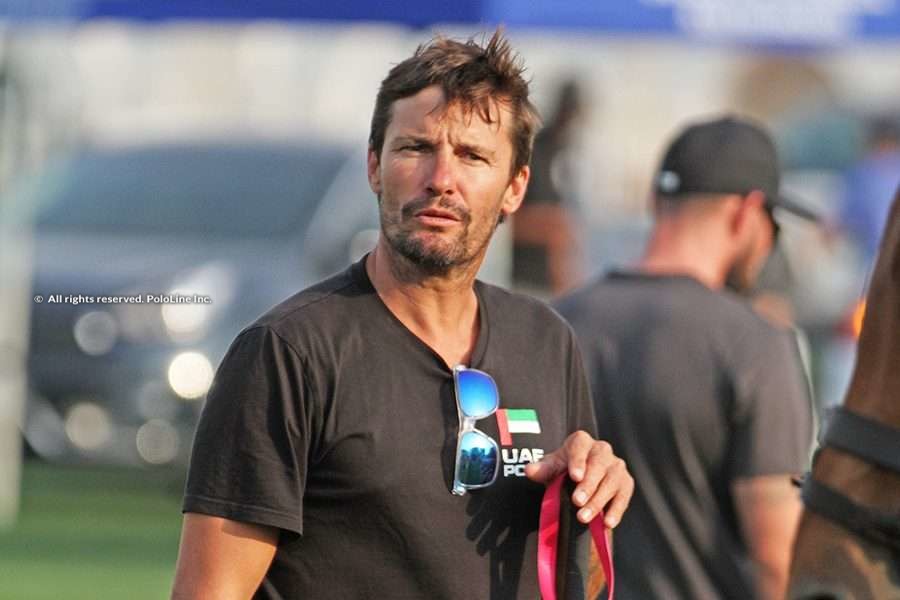By Alejandra Ocampo
If there is someone who knows about polo horses, it’s Lucas Monteverde. Not only did he win the Triple Crown and Argentine Open with La Dolfina on multiple occasions, but he has claimed many of the most prestigious international trophies as well. Monteverde is presently linked to UAE as the brain behind Sheikha Maitha’s team, a key component of the organisation’s success. He started in UAE as a player, before being was forced to retire from high-goal competition due to injury. He now takes on the role of advisor to the organisation. He is a fundamental part of UAE, recent Silver Cup finalists and double Gold Cup champions in Dubai. Monteverde and UAE are now preparing for their next challenge, the HH President’s Cup, hosted at Ghantoot Polo & Racing Club, in Abu Dhabi.
In conversation with Pololine, Monteverde shared some of his wisdom and his preferences when it comes to polo horses.
Can you describe your ideal polo horse?
The perfect horse does not exist. It has more to do with what each player chooses, what fits their position. The most important quality a good horse can have is the willingness to stand by you until the end, to not abandon you. A horse that can handle the pressure, the one that you know will never make you lose a play in the key moments of the match.
When you win important matches, each player is on their most important horse. Putting the list together properly and not giving your opponent the advantage when it comes to horses is one of the most important tasks for a team that is playing to win titles.
In your opinion, what is the most important characteristic of every good polo horse?
I consider the best horses to be the ones that have head and courage, apart from the conditions that all polo horses need, such as stopping and turning. Lots of horses can do those things but not all of them have the extra quality that has to do with the heart, the thing that lets you know that they will not let you down.
That is the most important quality for me, and you don’t know if you’ve found it until you are in the heat of competition. When you are breaking the horse in and training them, they can all appear to have the right conditions of stopping and turning. But only when you are on the field with other good horses will the horse be able to prove itself. That is why the mentality of the horse is important, for them to manage that pressure and maintain the same movements, the same mouth, and the nobility that good horses have, and never giving up.
What is the ideal number of horses to have in a string?
It is always important to bring new horses in every year, because the qualities I mentioned previously have a life span. Horses can always get injured, and there is a moment when they stop being what they were. The best age for horses to play is from 7 or 8 years old, to 12 or 14.
On average, how many new horses should join the string each year?
There are exceptions, mares that start playing before and that last a bit longer, but in all organisations, like UAE, for example, the aim is to bring new horses in each year. If you breed horses, you always have to bring something in from your breed. If not, you have to buy. But you must never just stick with what you have thinking that you are well mounted, otherwise your horses won’t last long.
What is the most important part of the training process?
They are all important. From birth, to what they eat, to having a good trainer that teaches them well, and most importantly, one that won’t ruin them. Breaking in a horse is important too, and nowadays it is being done well.
But in my opinion it is crucial that the horse be able to withstand the mental pressure. I insist that every stage is important, because if you make a mistake in one area, the final product will not work. However, if you did everything right and the horse does not have a strong mind, it won’t be the horse everybody wants it to be.
Which is, or has been, your favourite horse, and why?
Of the horses I have played, Turquita, an easy mare with a big heart is among my favourites. She was not the fastest, but she never gave up. She also had a good size and was very comfortable to ride. La Tía Loca, a thoroughbred, was not the most comfortable, but she had good mobility and an amazing stride which really showed on Palermo’s number one ground. She had a great mouth and good lungs, and handled the curves. When you hit a backhander, you knew as she turned that you would get there first.
Which is, or has been, the best polo horse you have ever seen play, and why?
I have seen a lot of good mares. The best time for me was undoubtedly the period with La Dolfina Cuartetera, when we played with Adolfito, Lolo, and Marano in La Dolfina. I then saw the ones at Ellerstina. I always thought Facundo Pieres’ Easy Go was amazing on the field when we played against each other in the final of the Argentine Open. Or Gonzalito on Fina Pepa. Dolfina Toro, as well, was incredible to see on the field. I could also mention Milo Fernández Araujo on La Paz.
Of the horses you have seen play, is there one in particular that you would like to try?
There are so many good horses! There were, are, and always will be thousands of good horses.

